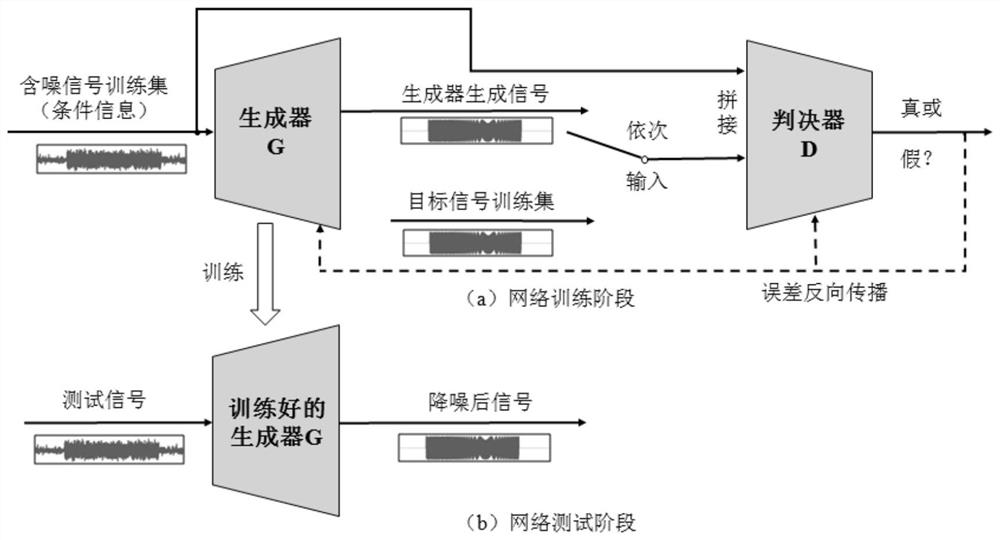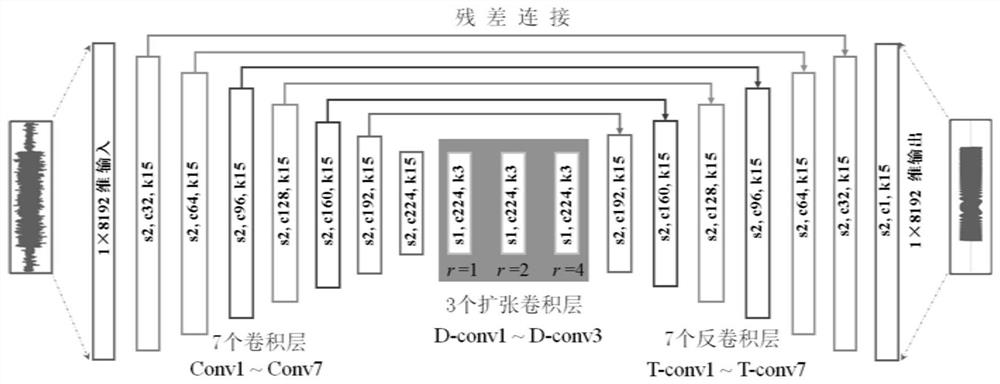Underwater acoustic signal noise reduction method based on generative adversarial network
An underwater acoustic signal and network technology, applied in the field of underwater acoustic signal, can solve the problems of limited noise reduction ability of low signal-to-noise ratio received signals, insufficient adaptability to complex ocean environments, etc., achieve good noise reduction effect, improve noise reduction performance, adaptable effect
- Summary
- Abstract
- Description
- Claims
- Application Information
AI Technical Summary
Problems solved by technology
Method used
Image
Examples
Embodiment 1
[0035] Such as figure 1 As shown, the embodiment of the present invention provides a method for noise reduction of underwater acoustic signals based on generating confrontation networks, including: a training phase and a testing phase; wherein:
[0036]The training phase includes: inputting the noise-containing signal training set into the generator to obtain the signal generated by the generator; splicing the signal generated by the generator and the target signal without noise respectively with the noise-containing signal, and inputting the judgment in sequence In the device; the decision device uses the noise-containing signal as condition information to identify the authenticity of another input signal input at the same time; calculates the error between the judgment result and the real label, and then uses the backpropagation algorithm to complete the generation of the confrontation network Update and optimize the network parameters, and get the trained generator model; ...
Embodiment 2
[0043] On the basis of the above embodiments, the embodiment of the present invention provides a generator construction method, such as figure 2 As shown, the structure of the generator includes: an encoder consisting of seven one-dimensional convolutional layers (Conv1~Conv7), three one-dimensional dilated convolutional layers (D-conv1~D-conv3) and seven one-dimensional A decoder composed of three-dimensional deconvolution layers (T-conv1~T-conv7); among them, each convolution layer in the encoder is connected to each corresponding deconvolution layer in the decoder by using a residual connection; in the In the above encoder, three one-dimensional dilated convolutional layers and decoder, except for the last one-dimensional deconvolution layer in the decoder, the LeakyReLU function of 0.1 is used to activate the output non-linearly after the output of the other layers .
[0044] Specifically, the encoder continuously compresses and reduces the dimensionality of the input si...
Embodiment 3
[0048] On the basis of the above-mentioned embodiments, the embodiment of the present invention provides a construction method of the decider, such as image 3 As shown, the structure of the decision device includes: 3 cascaded step-size convolutional layers (Conv8~Conv10) connected sequentially from the shallow layer to the deep layer, 1 one-dimensional convolutional layer (Conv11) and 1 single-node output A fully connected layer (Fc1); wherein, the three step-size convolutional layers use the same nonlinear activation function as the generator to extract features from the input signal.
[0049] Specifically, the one-dimensional convolution layer in the decision device is a convolution layer with a single convolution kernel, which is used to complete the compression of the feature channel, and connect the obtained one-dimensional feature vector to the fully connected layer, and finally use the The single-node output layer outputs the decision result. and figure 2 same in ...
PUM
 Login to View More
Login to View More Abstract
Description
Claims
Application Information
 Login to View More
Login to View More - R&D
- Intellectual Property
- Life Sciences
- Materials
- Tech Scout
- Unparalleled Data Quality
- Higher Quality Content
- 60% Fewer Hallucinations
Browse by: Latest US Patents, China's latest patents, Technical Efficacy Thesaurus, Application Domain, Technology Topic, Popular Technical Reports.
© 2025 PatSnap. All rights reserved.Legal|Privacy policy|Modern Slavery Act Transparency Statement|Sitemap|About US| Contact US: help@patsnap.com



